Transparent Cities of Transparency International Ukraine started cooperation with the EU Delegation to Ukraine in 2021 as part of project E-platform of interaction between citizens and local governments to ensure accountability and good governance. This activity is a logical continuation of our previous developments designed to increase the transparency and efficiency of urban governance. We have started implementing the project's key goals, namely:
- strengthening the capacity of local NGOs;
- promoting transparency and accountability of local government through innovative governance practices;
- promoting the implementation of good governance practices by local government.
To ensure a deeper understanding of the problems and requests of both local authorities and active citizens, most of the project's tasks were implemented in partnership with Platform for Public Control and Center for Public Monitoring and Research NGOs.
Our interaction came at a turbulent and difficult time. First, COVID-19 affected the conditions in which cities were forced to function, in particular during the continuous anti-epidemic restrictions, the weakening of dialogue with the public, and additional costs. Then the full-scale russian invasion created challenges for city councils they had never faced before. But despite everything, we stood side by side with cities, developed recommendations for them, offered platforms for interaction and sharing experiences, and sent humanitarian aid.
In this article, we will summarize the results of our cooperation with the EU Delegation and share our achievements.
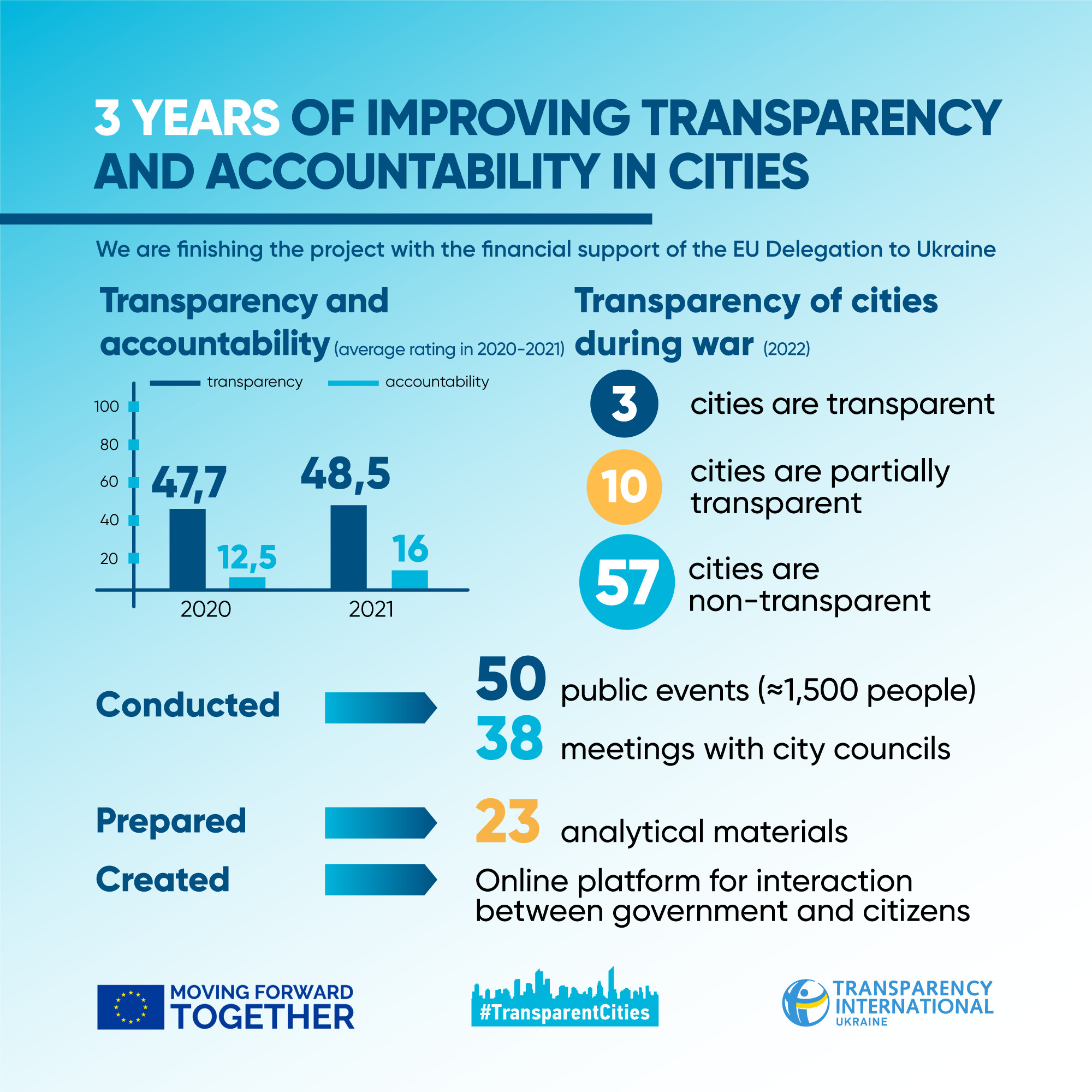
Transparency and Accountability Ranking of cities
One of the key directions of the Transparent Cities program was the Transparency Ranking of local governments. The main idea of ratings is to evaluate the situation with municipal administration. It shows the readiness of city authorities to overcome corruption risks by publishing information in the public domain and developing mechanisms to engage citizens in decision-making.
- 100 largest cities were evaluated by 84-88 (depending on the year) indicators in 14 spheres — Information on the work of local government, Access and participation; Access and participation; Procurement; Housing policy; Budget process; Financial and material assistance, grants; Social services, HR matters, Anti-corruption policy and professional ethics; Land use and construction policy, Municipal enterprises; Municipal property; Education; Investment and economic development.
In 2021, in cooperation with representatives of the Lviv Regulatory Hub, our team developed and supplemented indicators of investment and economic development. The added requirements reduce administrative barriers and improve the business climate at the local level.
- In 2020, the average level of city transparency was 47.7 points, and in 2021 — 48.5 points. Over 5 years of rating, the average indicator has grown by 62.2%.
- The top five cities have changed over the past 2 years. In 2020, Mariupol, Lviv, Drohobych, Vinnytsia, and Ternopil were the top 5 most transparent cities. But in 2021, the rating leaders were Mariupol, Lviv, Dnipro, Drohobych, and Mukachevo. This is the first time in the five years of the program's existence that 5 city councils have received the status of transparent.
Since 2020, the program has started to study the level of accountability of cities. Platform for Public Control and Center for Public Monitoring and Research NGOs became our partners in those endeavors. The analysis of city council accountability showed the real situation: an assessment of the practical activities of local self-government bodies and their interaction with the public.
- 50 city councils (5 leaders of the Transparency Ranking-2019 and 45 largest cities) were analyzed for the implementation of 47 indicators in 2020 and 48 in 2021. The criteria covered 14 spheres: Information on the work of local government; Access and participation; Procurement; Housing policy; Budget process; Financial and material assistance, grants; Social services; HR matters; Anti-corruption policy and professional ethics; Land use and construction policy; Municipal enterprises; Municipal property; Education; Investment and economic development.
- The average accountability indicator was significantly lower than the transparency indicator, reaching 12.5 points in 2020 and 16 points in 2021. This gap is due to the complexity and novelty of indicators in the Accountability Rating, as well as the gap between the formal and practical openness of cities.
- The top five leaders of the accountability rating were: Mariupol, Lviv, Pokrov, Bila Tserkva, Chernivtsi (in 2020), and Mariupol, Dnipro, Ternopil, Lviv, and Bakhmut (in 2021).
In the winter of 2020, the Transparent Cities launched a special online platform for interaction between citizens and local authorities. The platform allows activists and residents to discuss disturbing city issues, and draw the attention of local authorities to problems. And local self-government bodies can respond to comments, upload evidence, share experiences, and learn about the best practices of urban self-government.
"Communities can tell the most about the accountability of local authorities. Accountability assessment could not be accurate without them, thus engagement is important. The platform of interaction between citizens and local governments to ensure accountability and good governance was created exactly for that purpose: to give people a simple tool to record practical cases with transparency or accountability issues or achievements, — said Manfredas Limantas, ex-coordinator for Rule of Law and Anti-Corruption with the EU Delegation to Ukraine.
- 34 city councils and 67 civil society organizations (CSOs) from different regions of Ukraine participated in the platform. Of these, 21 CSOs were directly involved in the assessment of city councils' accountability.
- About 56 thousand users have visited the online platform since its launch to this day, and 18-19 thousand people visit it annually.
- The platform contributed to strengthening the role of the public as “controllers” of the political situation and agenda at local levels. On it, active citizens and representatives of public organizations left 430 general reviews regarding 14 studied spheres, and more than 2000 reviews on specific indicators.
- In May 2021, Transparent Cities electronic platform won Web Awards UA, the national competition of websites and applications in nomination "Non-profit and government organizations" and was highly evaluated for content, design, convenience, and adaptability.
Transparency of municipal governance in times of war:
The war has become a big challenge for Ukrainian cities, which had to work under continuous shelling, destruction, and hitting of critical infrastructure, the migration crisis, and resource constraints. Some cities were occupied or are in close proximity to the front.
"It is beyond all questions that local authorities are working in conditions of unprecedented round-the-clock challenges. The security of citizens, obviously, has become the core task, and the transparency issue may not compete with that. But at the same time, Ukrainian city councils should move towards transparency as much as possible. After all, this is exactly what their voters and international partners expect from them – they are even more interested in the transparency of the Ukrainian authorities since the invasion.", – says Andrii Borovyk, CEO of TI Ukraine.
With this in mind, the Transparent Cities team adapted the study of city councils' transparency by adding criteria related to adaptation to war, support for businesses, and IDPs. 70 rear city councils were analyzed by 40 criteria.
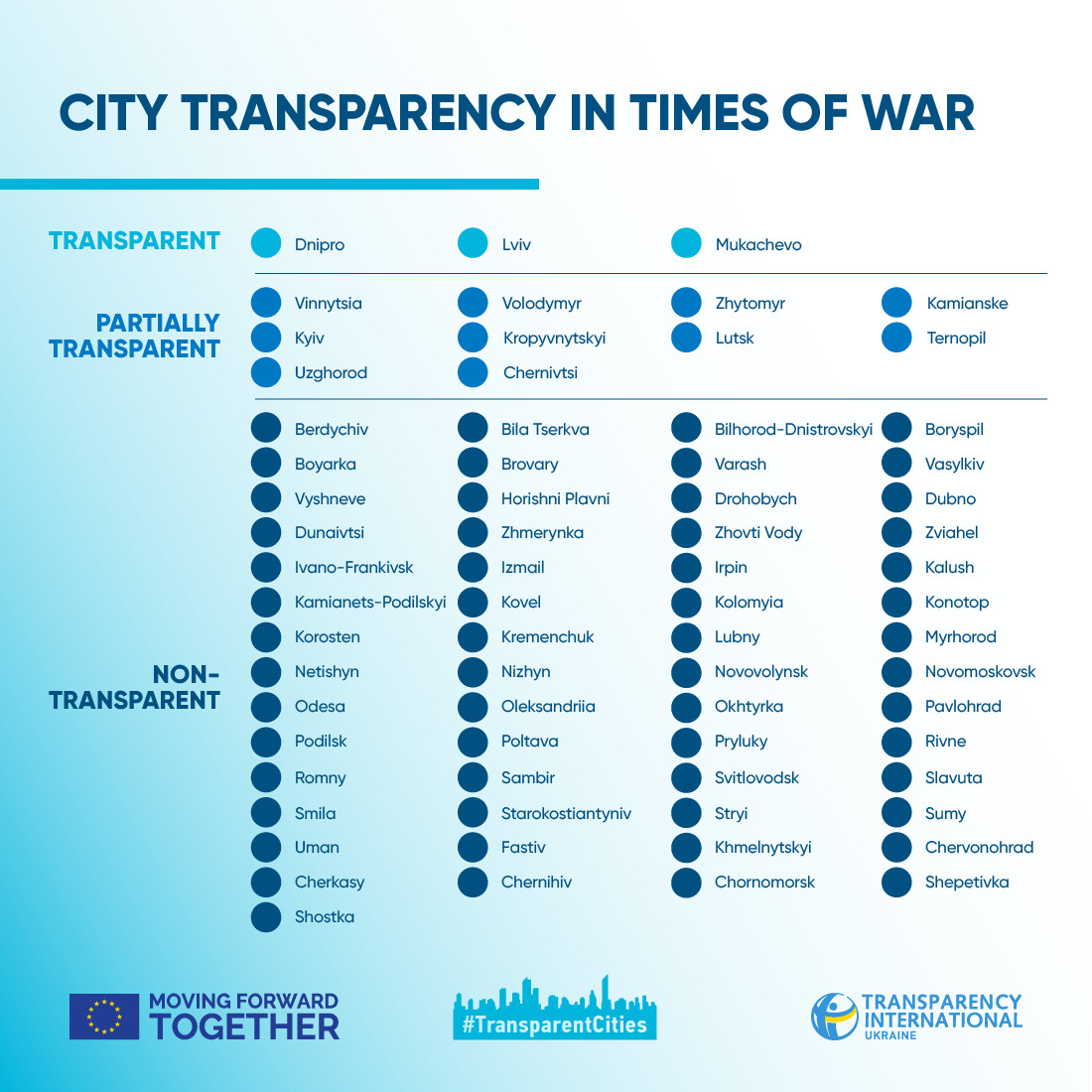
Based on the results of the study:
- 3 cities (Dnipro, Lviv, and Mukachevo) received the status of transparent. Another 10 (Vinnytsia, Volodymyr, Zhytomyr, Kamianske, Kyiv, Kropyvnytskyi, Lutsk, Ternopil, Uzhgorod, and Chernivtsi) are "partially transparent". The remaining cities (57) were "non-transparent".
- The average indicator performance rate was 37.5%. Indicators that are legal requirements were met more often (47.8 %), and indicators that are best practices were implemented by 27.8%.
- The least implemented indicators were those that required significant resources, special digital skills and/or the capacity (including financial) to ensure continuous implementation (electronic auctions or online broadcasts of meetings).
- Analysts have recorded that there is a correlation between the city's transparency level as of December 2022 (in the new survey format) and its performance in the 2021 transparency rating. In other words, cities that were relatively transparent before the war also showed a higher level of transparency in 2022.
New study of Transparent Cities as a response to the challenges of war
During the war, Ukrainian cities began or continued to work in relatively new spheres. We decided to explore not only the transparency and accountability of municipal administrations but also a wider range of topics. So, we started a study of housing policy, open data during the war, decolonization of toponyms, twinning of cities, and recovery cases. We provide ongoing recommendations on all topics that should be implemented to improve cities.
- Open data during the war
The study covered 18 big cities in Ukraine, to which the Ministry of Digital Transformation restored access to a Unified State Open Data Web Portal in August 2022. The results of our study show that as of December 1, 2022, the average rate of data disclosure in the studied cities was only 25.1% (258 of 1026 of mandatory data sets for all local self-government bodies). Most often, cities published data on deputies of local councils, in particular contact information and reception hours, electronic petitions, as well as the results of roll-call voting at plenary sessions. Information about the construction sector, investment contracts, municipal services, landscaping, and so on was published less often.
The program insists that martial law is not a reason to "delay" transparency and accountability everywhere, especially in the rear cities. It is important for local authorities to find the resources and opportunities to implement these principles at the pre-war level, where possible.
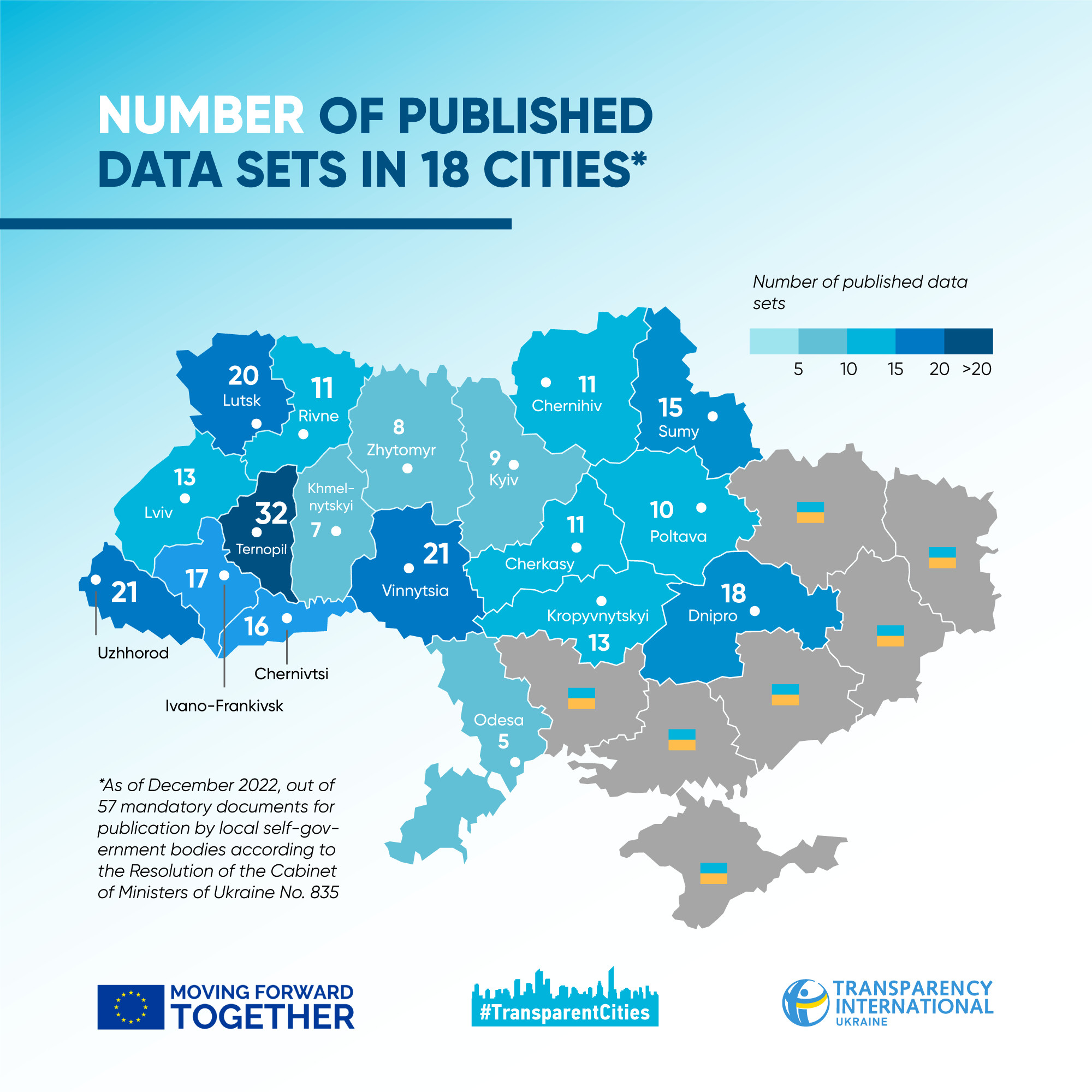
- Twinning cities and their help during the war
The war updated a new concept of urban cooperation — the conclusion of agreements on twinning and kinship of municipalities. Studies conducted during 2022 showed that among the 50 most transparent cities in Ukraine, the following data were recorded: 39 new connections with foreign cities regarding cooperation in the area of education, science and youth policy, economy and investment, healthcare, housing and utility services, humanitarian rehabilitation and investment.
In addition, foreign cities (both new and those that agreed on cooperation long before the full-scale war) have supported their Ukrainian sister cities with humanitarian supplies more than 160 times.
In total, the team prepared 8 analytical materials on the twinning procedure, including recommendations on establishing of twinning relationship and tips on how to minimize corruption risks when receiving aid from abroad.
- Derussification of toponyms
After a full-scale russian invasion, Ukrainian cities intensified the processes of renaming toponyms associated with the empire, its public figures and events. The change of names is important primarily because of the existing request of society, the need to get rid of imperial symbols and the need to honor those who fought and are fighting for our state. Program recorded more than 3,200 toponyms renamed in 50 cities studied between March 2022 and June 2023.
Our analysts talked to experts about the most common problems of decolonization of names, evaluated the progress of cities on this issue and how toponyms are renamed abroad in support of Ukraine . We have also developed the Guide to Derussification and Decolonization of Ukrainian Cities, which will be helpful for cities.
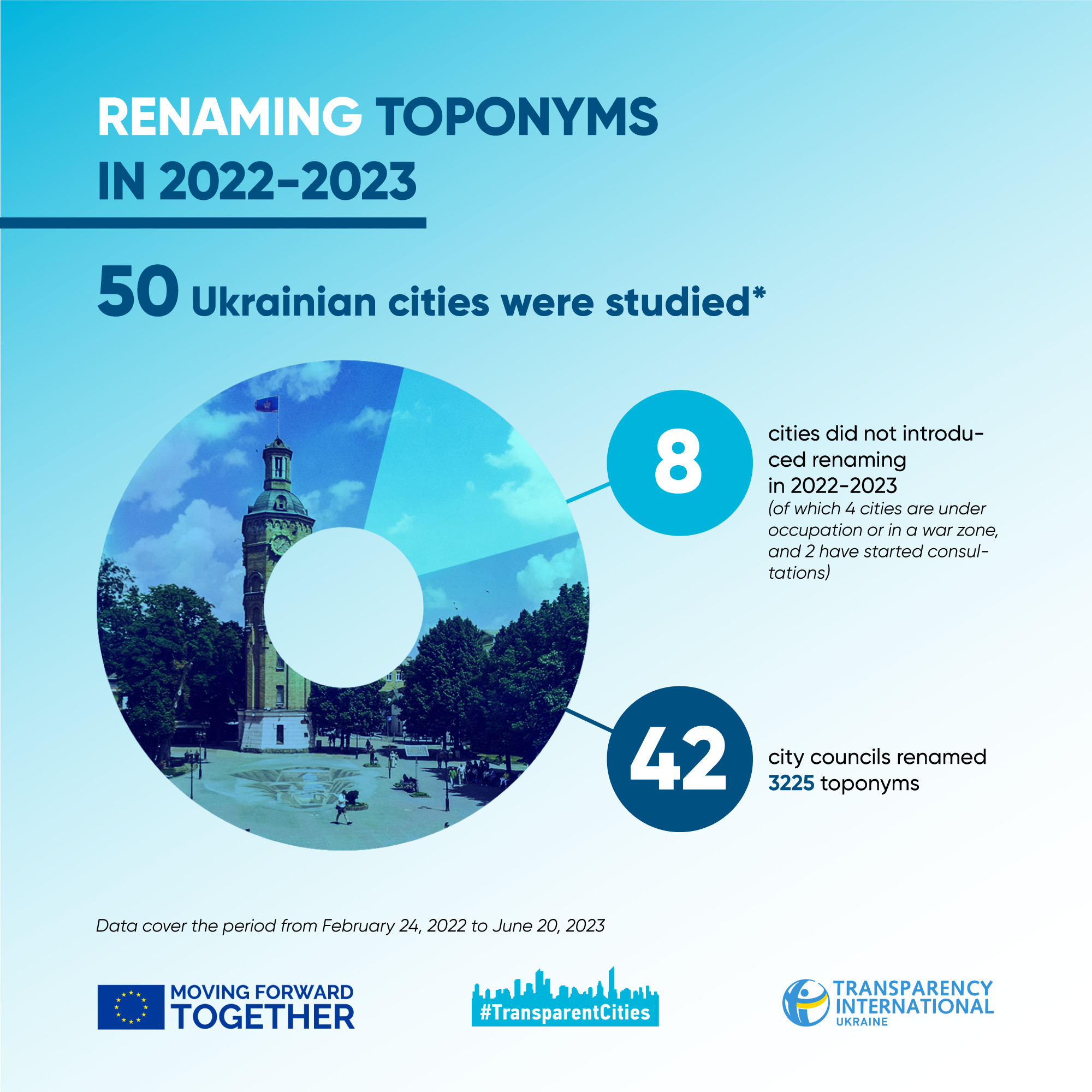
- Housing policy
3.2 million citizens' housing is destroyed or damaged, at the same time 5.4 million Ukrainians became internally displaced persons. Ukraine is facing an unprecedented housing crisis in all the years of independence. "In January 2021, there were only 3,095 apartments in Ukraine from the social and temporary housing fund, which is of course not enough in conditions when millions of people leave their permanent place of residence, — Bohdan Balyuk, analyst at Transparent Cities, is convinced.
The team analyzed international experience of regulation of rent prices and its effects, risks associated with government intervention, and suggested mechanisms for reasonable implementation of those policies. We also explained why it is important to invest in development of social housing and how world experience can help in overcoming the housing crisis in our country.
- Foreign experience of urban reconstruction
The war continues, but it is now the time to think over and plan the restoration and modernization of cities, reconsider the values and significance of cultural and historical sites. The experience of the post-war reconstruction of Europe shows that plans often began to be developed long before 1945, and the process itself covered much more than the physical reconstruction of the destroyed facilities. We have analyzed 21 recovery cases around the world to recommend what practices should be avoided or followed during the recovery and how local authorities should act during that process.
- How our rear cities overcome the challenges of war
While some cities are under occupation, surrounded or fighting fiercely for our freedom and future, others in the rear hosting IDPs and relocated businesses, opening rental points for basic necessities, collecting and transmitting humanitarian aid, and supporting Ukrainian soldiers. We have studied more than 30 rear cities and towns and how they resisted the circumstances that developed due to the Russian invasion.
- Training for cities
We conducted training for cities, encouraging them to increase transparency and accountability, as well as introduce good practices of local self-government.
Over the past 3 years, the project team has organized or co-organized 50 events attended by about 1,500 people, including 38 meetings with city councils. For example in 2021, personal consultations were provided to 26 city councils (both on transparency and accountability) — Lviv, Mariupol, Pokrov, Novomoskovsk, Khmelnytskyi, Zaporizhzhia, Vasylkiv, Kostiantynivka, and others. These are both oblast centers or small towns by population. In addition, we held meetings with both leaders and outsiders of transparency and accountability ratings, because the key condition for the meeting was a request from city councils. However, in 2023, analysts provided consultations for 6 city councils to improve the transparency during the war: Drohobych, Stryi, Mukachevo, Sumy, Shostka and Chervonohrad.
Finally, the program created tools for the development of municipal administration or solving individual challenges of cities. We have published on our platform 20 standard document templates, collection of best practices, and Guide to Derussification and Decolonization of Ukrainian Cities.
Our interaction with the audience and the media
- Within the framework of the program's cooperation with the EU Delegation, our campaign to raise awareness of the principles of good governance has shown significant results. For example, views of published content on the online platform and Facebook page reached about 800 thousand views in three years.
- The most popular page on the online platform was Transparency Ratings of City Councils; and Mariupol and Lviv were the most searched.
- Our pages received the most views from Ukraine (in particular, Kyiv, Lviv, and Dnipro), the USA, and Poland.
- The program has prepared 23 materials about city administration initiatives, proactive cities, implemented best practices, and so on. Also, we were on air 10 times on national radio and TV, and our 37 stories were broadcast on national and regional TV channels. Transparent Cities program had almost 1000 mentions for 3 years.
Assistance to cities
Later, the program established the Emergency Fund to support the Transparent Cities. It's key purpose is to cover the needs of cities during the war, in particular in weapons, special equipment, etc.
"We were aware of the scope of problems the cities are facing now, and that it is difficult to overcome them on their own, especially when it comes to small towns that have also been destroyed. Therefore, the Program invited the EU Delegation to Ukraine to create the Fund that helped cover basic needs, for example, in technical equipment. And our initiative was supported!", - says Anastasia Mazurok, COO at TI Ukraine.
During the war, various cities come to us for emergency assistance — de-occupied, those that suffered from the bombing of the Kakhovka Hydroelectric Power Plant by the russians or the destruction of the Ukrainian energy system, as well as those that were under the enemy's blockade or under constant shelling. The Program helped to Chernihiv, Chuhuiv, Izium, Kupiansk, Lyman, Kherson, and Pokrov.
For example, thanks to the received equipment, the cities created heating points or resumed operations of local self-government bodies in locations where all administrative institutions were looted or destroyed during the exit of the russian troops, self-proclaimed authorities and collaborators.
In May 2023, the Program conducted a survey among the city councils regarding their current needs. We received 84 responses from cities from all over the country, including occupied, rear, large cities and small towns. Of the requests sent, 18 were identified, which we were able to fully or partially cover wit the Emergency Fund: Druzhkivka, Okhtyrka, Pavlohrad, Sloviansk, Sumy, Bakhmut, Kropyvnytskyi, Zaporizhzhia, Irpin, Korosten, Konotop, Kupiansk, Lyman, Pokrovsk, Pokrov, Lysychansk, Severodonetsk, and Nikopol.
Thanks to this assistance, a support center for IDPs was set up in Konotop. And in Irpin, the local Administrative Service Center received laptops and a charging station to provide services to the local population and IDPs. Zaporizhzhia and Nikopol use the received tablets for the work of teams recording the consequences of attacks on cities by russian troops, and Sloviansk uses the received generators to overcome the consequences of enemy attacks, as well as for arranging shelters.
The foundation's work was also aimed at helping communities that moved to other cities controlled by Ukraine due to occupation or significant destruction. — Lysychansk, Severodonetsk, and Bakhmut. Now these cities are opening hubs and support centers for IDPs all over Ukraine, and this is where our assistance was directed.
In addition, assistance was provided to frontline and de-occupied cities, as well as those that were significantly affected by shelling during the full-scale invasion of the russian federation in Ukraine (Pokrov, Lyman, Izium, Kherson, Irpin, and others).
In total, the Fund's geography covered 11 regions of Ukraine — Dnipropetrovsk, Donetsk, Zhytomyr, Zaporizhzhia, Kirovohrad, Kyiv, Luhansk, Sumy, Kharkiv, Kherson, and Chernihiv.
The city councils mostly asked to purchase the goods ensuring:
- elimination of the consequences of destruction caused by russian aggression (pumps for pumping water, special generators);
- creation of special hubs and IDPs centers (generators, charging stations, heaters, heat curtains, LED lamps, flashlights, power banks, etc.);
- organization of operation of city councils, including inspection of damaged and destroyed buildings (laptops, tablets, multifunctional equipment, for example, printers, scanners and copiers).
The total price of purchased goods is about UAH 2.7 million.
Also, during the period from July to December 2022, our Fund collaborated with Central Ukrainian Volunteer Organization” (Kropyvnytskyi). Together, we promptly helped to cover citizens' requests for food, hygiene products, and medicines. A total of 79 tons of cargo were sent. This assistance covered 10 regions — Vinnytsia, Dnipropetrovsk, Donetsk, Zaporizhzhia, Kyiv, Kirovohrad, Mykolaiiv, Kharkiv, Kherson, and Cherkasy.
The team supported hub coordination and operation, monitored and managed resources as they moved and stored, collected requests from communities and supported logistics within the country (fuel supply).
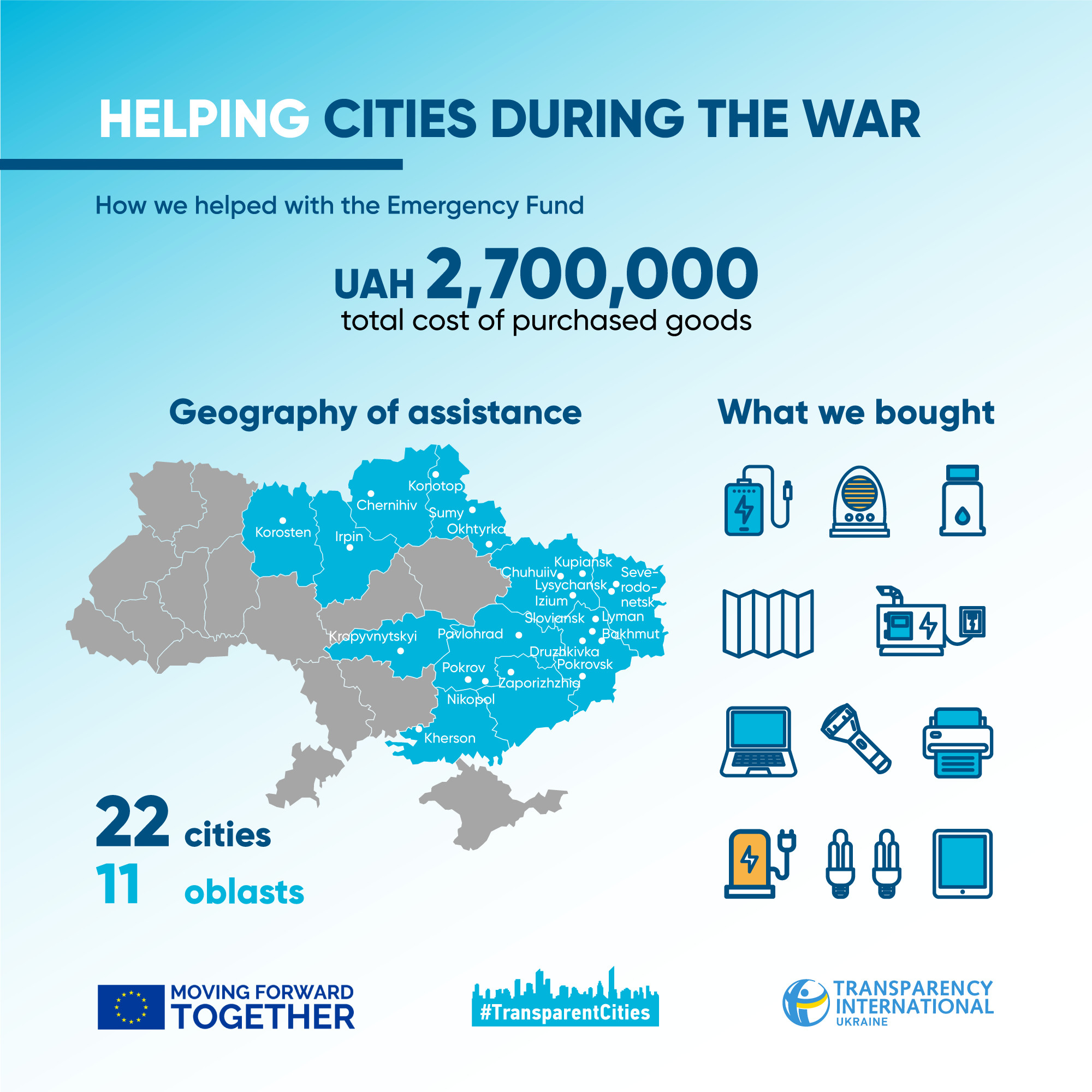
We thank our partners for their support and joint achievements!
Transparency International Ukraine continues to work on the development of the Transparent Cities program and the implementation of new ideas designed to make our unbreakable cities even more successful and strong.